

Open Knowledge: Home. New York Public Library Invites a Deep Digital Dive. Photo Mansion Maniac, a whimsical online toy created by the New York Public Library, may seem like envy bait for the real-estate have-nots.
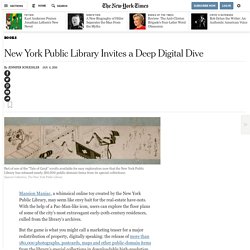
With the help of a Pac-Man-like icon, users can explore the floor plans of some of the city’s most extravagant early-20th-century residences, culled from the library’s archives. But the game is what you might call a marketing teaser for a major redistribution of property, digitally speaking: the release of more than 180,000 photographs, postcards, maps and other public-domain items from the library’s special collections in downloadable high-resolution files — along with an invitation to users to grab them and do with them whatever they please.
Digitization has been all the rage over the past decade, as libraries, museums and other institutions have scanned millions of items and posted them online. Google Open-Sourcing TensorFlow Shows AI's Future Is Data. When Google open sourced its artificial intelligence engine last week—freely sharing the code with the world at large—Lukas Biewald didn’t see it as a triumph of the free software movement.
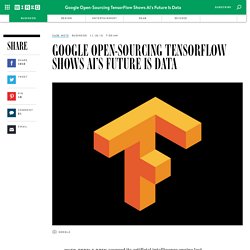
He saw it as a triumph of data. That’s how you’d expect him to see it. He’s the CEO of the San Francisco startup CrowdFlower, which helps online companies like Twitter juggle massive amounts of data. But after spending time at the Stanford AI Lab, he knows artificial intelligence. And his point is a good one. 'What they're not opening up is their data. In open sourcing the TensorFlow AI engine, Biewald says, Google showed that, when it comes to AI, the real value lies not so much in the software or the algorithms as in the data needed to make it all smarter. “As companies become more data-driven, they feel more comfortable open sourcing lots of [software]. Making Machines Smarter TensorFlow, you see, deals in a form of AI called deep learning.
Open Knowledge: Home. Opendata.ch. Wikidata. Wikimedia Foundation. American non-profit charitable organization As of 2017[update], the foundation employs over 300 people, with annual revenues in excess of US$109.9 million.[9] María Sefidari is chair of the board.[3] Katherine Maher has been the executive director since March 2016.
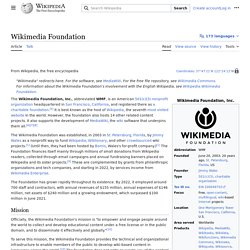
Goal[edit] The Wikimedia Foundation has the stated goal of developing and maintaining open content, wiki-based projects and providing the full contents of those projects to the public free of charge.[10] Another main objective of the Wikimedia Foundation is political advocacy.[11] History[edit] In 2001, Jimmy Wales, an Internet entrepreneur, and Larry Sanger, an online community organizer and philosophy professor, founded Wikipedia as an Internet encyclopedia to supplement Nupedia. In April 2005, the U.S. On September 25, 2007, the foundation's board gave notice that the operations would be moving to the San Francisco Bay Area. In 2009, the Wikimedia Foundation's headquarters moved to New Montgomery Street. Christian Kreutz (ckreutz) Open Science Collaboration Blog · The State of Open Access. By Shauna Gordon-McKeon To celebrate Open Access Week last month, we asked people four questions about the state of open access and how it's changing.
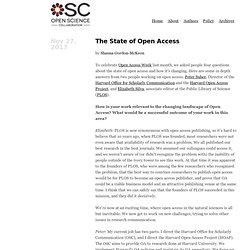
Here are some in depth answers from two people working on open access: Peter Suber, Director of the Harvard Office for Scholarly Communication and the Harvard Open Access Project, and Elizabeth Silva, associate editor at the Public Library of Science (PLOS). How is your work relevant to the changing landscape of Open Access? What would be a successful outcome of your work in this area?
Elizabeth: PLOS is now synonymous with open access publishing, so it’s hard to believe that 10 years ago, when PLOS was founded, most researchers were not even aware that availability of research was a problem. We’re now at an exciting time, where open access in the natural sciences is all but inevitable. Peter: My current job has two parts.
To me success would be making OA the default for new research in every field and language. Why was this secret? Open Access Map. Urban Data Challenge. Open Access. The Case for Open Access Open Access (OA) stands for unrestricted access and unrestricted reuse.

Here’s why that matters. Most publishers own the rights to the articles in their journals. Anyone who wants to read the articles must pay to access them. Anyone who wants to use the articles in any way must obtain permission from the publisher and is often required to pay an additional fee. Although many researchers can access the journals they need via their institution and think that their access is free, in reality it is not. Paying for access to content makes sense in the world of print publishing, where providing content to each new reader requires the production of an additional copy, but online it makes much less sense to charge for content when it is possible to provide access to all readers anywhere in the world.
PLOS Takes a Different Approach PLOS applies the Creative Commons Attribution (CC BY) license to works we publish. Open Data Protocol (OData) The Open Data Handbook — Open Data Handbook. Knowledge for everyone. NYC Open Data. Open Data Commons. Transparent Africa. The Open Data Foundation. The World Bank.
Open Data Portal. 0 Have you ever wondered… which of Europe’s countries has the greenest energy supply?
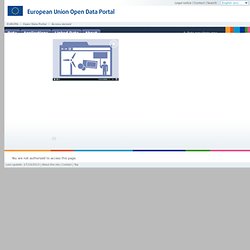
Or which of its economies are growing fastest? Or which organisations are lobbying the EU? Or how EU public funds are being spent? The EU gathers and generates data about these and about many other things. This data is like a digital echo of the world around us which we can use to improve our understanding of important issues and to make better decisions. Data.gov.uk. Home. Open data. Urban Data Challenge: Zürich. Overview What’s the heartbeat of your city? Does data make your pulse race? Buses, trams, bicycles, pedestrians, and cars zoom about modern cities like blood pulsing through the body. But with urban growth comes challenges—one of them is how to improve transportation.